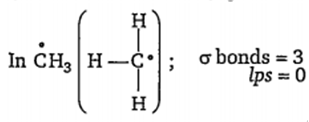 Multiple Choice Questions
Multiple Choice QuestionsConsider the following ions:
(i) Ni2+ (ii) Co2+ (iii) Cr2+ (iv) Fe3+
(Given, at. no. Cr = 24, Fe = 26, Co = 27, Ni = 28)
The correct order of magnetic moment of these ions is
(i) < (ii) < (iii) < (iv)
(iv) < (ii) < (iii) < (i)
(i) < (iii) < (ii) < (iv)
(iii) < (iv) < (ii) < (i)
Geometry of methyl free radical is
pyramidal
planar
tetrahedral
linear
B.
planar
Number of hybrid orbitals = number of σ bonds + number of lps.

Number of hybrid orbitals =3 + 0 =3
Hence, hybridisation is sp2 and geometry is planar. Methyl free radical is highly reactive due to the presence of one unpaired electron.
The electron configuration of the oxide ion is much most similar to the electron configuration of the
sulphide ion
nitride ion
oxygen atom
nitrogen atom
Favourable conditions for the formation of electrovalent bond is that the cation and anion must have, respectively
high ionisation potential and low electron affinity
low ionisation potential and high electron affinity
high ionisation potential and high electron affinity
low ionisation potential and low electron affinity
Consider the formal charges on N and B in H3N-BF3 and indicate which of the following is true?
N is +ve and B is -ve
N is --ve and B is +ve
both N and B carry similar +ve or -ve charges
charge discrimination is difficult to make
Consider (i) CO2 (ii) CCl4 (iii) C6Cl6 and (iv) CO and tell which of the following statements is correct?
(i), (ii) and (iii) only have zero dipole moment
(i), (ii) and (iv) only have zero dipole moment
only (iv) has zero dipole moment
All have zero dipole moment
Which one of the following represents the correct state of hybridisation of P in PCl5 ?
s0p3
sp3d
s2p3
sp2d2
